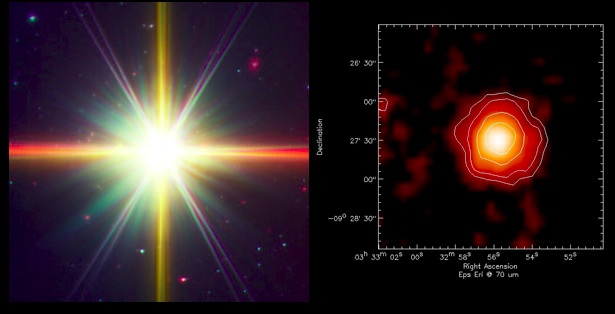Imaging of young planetary systems

After 20 years since the first extrasolar planet, 51 Peg b, was discovered by Mayor and Queloz, there are still many obscure points in how planetary systems form and evolve. In particular, the dynamics of young planetary systems and the processes responsible for the large eccentricities of some orbits are still unresolved questions. The key to attack these issues is to study planetary systems characterized by the presence of “debris disks” and perturbed by brown dwarf companions. Debris disks are dust clouds produced by ongoing collisions between small bodies analogous to asteroids and comets (similar to the ring system of Saturn but on a planetary system scale). The internal structure of these disks can reveal the presence of planets as the disk acts as a “canvas” on which the gravity of unseen bodies can “draw” dynamical signatures like rings, warps, central holes, radial gaps and azimuthal asymmetries. Identifying planets and other low mass bodies (such as brown dwarf companions) in such systems, and mapping their interactions with the disk, would provide much needed constraints on dynamic models describing the evolution of young planetary systems.
The Spitzer Space Telescope is the ideal instrument for this kind of research. The instruments hosted on the spacecraft cover the infrared wavelength range where the thermal emissions from debris disk, planet and brown dwarfs are stronger, where the contrast with the radiation emitted from the central star is higher, and where important diagnostic molecular and dust features are present. As part of the IRAC GTO time, we have observed with all three Spitzer instruments the four debris disk stars closer to the Sun. Our observations have already produced unexpected surprises, such as evidence of a recent catastrophic collision in the Vega planetary system (Su et al., 2005 [3]), detection of previously unknown dust components in the Fomalhaut disk (Stapelfeldt et al., 2004 [4]) and evidence of an “asteroid belt” internal to the signature dust ring around ε Eridani (Backman et al., in preparation). Our search for low mass companions around these same stars has allowed us to set strong limits on the mass of widely separated planetary mass companions to ε Eridani (Marengo et al., 2006 [2]).

ε Eridani harbors the closest known planetary system outside our own. With an age of ~850 Myr and a K2V spectral type, it is the best available example of a younger, dustier Solar System analog. ε Eridani is home of at least a Jupiter-size planet and a debris disk indicating that its planetary system is still in formation. The left panel shows an image of ε Eridani taken with the Spitzer mid-IR camera IRAC (Marengo et al. 2006). The right panel shows the ε Eridani debris disk as seen at 70 μm by Spitzer far-IR imager MIPS (Backman et al., in preparation).
We are currently searching brown dwarf and planetary mass companions around more stars. We have already identified two new brown dwarfs orbiting nearby stars (Luhman et al. 2006 [5]). One of these brown dwarfs, HD 3651 B, is especially important because it orbits a system with a known Jovian class planet, and is thus the first example of planetary system with a brown dwarf companion. Such an arrangement is very peculiar, and may explain the large eccentricity measured in the planet’s orbit, opening the possibility of studying for the first time the effects of the gravitational perturbations of widely separated low mass companions onto a planetary system. The search is still in progress, with new Spitzer observations that can potentially find companions with mass as low as a few Jupiter masses.

Spitzer/IRAC detection of the T7.5 brown dwarf HD 3651 B (Luhman et al. 2006)

For more information:
[1] The Dust and Gas Around beta Pictoris, Chen, C.H. et al. 2007, ApJ 666, 466
[2] A Spitzer/IRAC Search for Substellar Companions of the Debris Disk Star ε Eridani, Marengo, M., et al. 2006, ApJ 647, 1437
[3] The Vega Debris Disk: A Surprise from Spitzer, Su, K.Y.L et al. 2005, ApJ 628, 487
[4] First Look at the Fomalhaut Debris Disk with the Spitzer Space Telescope, Stapelfeldt, K.R., et al. 2004, ApJS 154, 458
[5] Discovery of Two T Dwarf Companions with the Spitzer Space Telescope, Luhman, K.L. et al. 2007, ApJ, 654, 570
